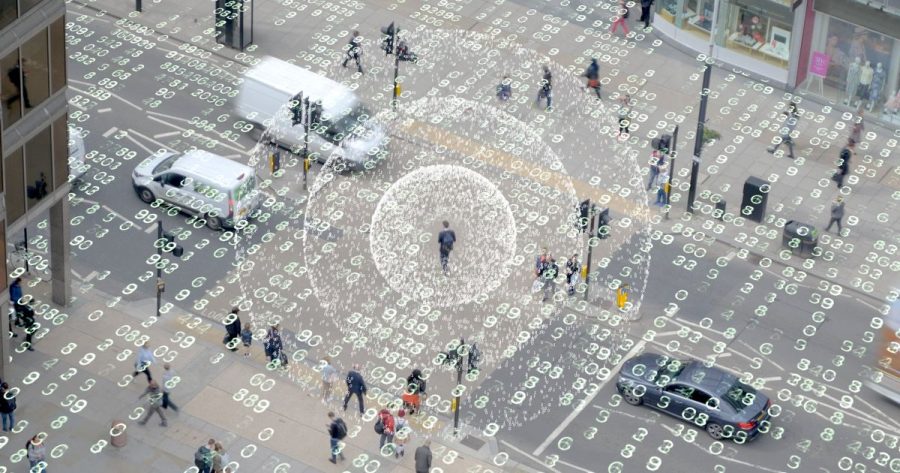Mass Surveillance in the Digital Age: The Rise of Co-Appearance Tracking
March 15, 2023
New Surveillance Technology Raises Concerns About Privacy Infringement, Civil Liberties Violations
Mass surveillance is the use of technology for monitoring and collecting data from people, often without their knowledge or consent. You know, that stuff you are warned about when using certain viral apps on your phone– spying, data collection, and much bigger invasions. Technology has made mass surveillance cheaper, more accessible, easier to use, and more advanced than ever before.
The United States government has used technology of various types to monitor citizens, usually justified, under the claim of national security, crime prevention, and investigation. The National Security Agency (NSA) was revealed to be collecting metadata on millions of phone calls made in the US after the 9/11 attacks. This sparked a national debate about the balance between privacy and security for Americans. Also, many may remember the story about the data that Edward Snowden leaked to the press about other incidents of mass surveillance and privacy invasion by the U.S. government.
Mass surveillance allows organizations– including law enforcement– to view the online activities of all of us, including social media usage, email communication, and web browsing history. Sometimes with a warrant, sometimes without depending on the ethics of the agency using the technology. The use of facial recognition technology by law enforcement has also become more widespread than in the past, with some cities using it to track individuals at protests and other public events. There are debates about racism, profiling, and bias in face scanning and surveillance technologies. This ties into a new tool being used in some parts of the U.S.
One company currently making this type of technology is making waves with new advances. Vintra is a company that specializes in video analytics and surveillance technology. They have been in the headlines because their video surveillance technology is equipped with a new co-appearance feature. The co-appearance feature is used to identify and track individuals who appear together in video footage. Patterns can be built based on who is in proximity to whom on a regular basis. These patterns are determined by artificial intelligence. This means these devices can figure out who we spend time with, including time, frequency, and place.
This technology has the potential to be used by law enforcement agencies to track individuals who are not suspected of a crime, solely because they happen to be in the same location as someone who is. This is a groundbreaking new feature taking surveillance technology to the next level. As a digital privacy advocate, I have concerns about the implications of this technology and how it may infringe upon our privacy.
This technology has a “big brother is watching you” vibe to it reminiscent of the book “1984” by George Orwell. Critics have likened this technology with similar in use by the Chinese government to surveil their citizens. According to the LA Times; “Vintra’s technology could be used to create ‘a more basic version’ of the Chinese government’s capabilities.” For this reason further investigation into this technology is warranted.
All mass surveillance-style technology must be regulated and safeguards must be put in place to protect our privacy and civil liberties. It can not be left up to third-party companies or law enforcement agencies to determine the proper use of this technology. The track record of these agencies is already marred with ethical flaws and bias. Besides being creepy, AI-based digital surveillance and the Co-Appearance feature has the potential for widespread abuse and violations of our privacy.
An important reality to consider is the potential for warrantless mass surveillance to become acceptable in any way. Cameras are already everywhere in major cities. The Co-Appearance feature could allow authorities to monitor and track the movements of large groups of people. This would be an infringement on our right to privacy and could discourage people from associating freely with others.
Just like face scanning technology, tools like Vintra can be used for discriminatory purposes. If the algorithm used to identify Co-Appearance is biased, it could unfairly target certain groups based on race, gender, or other parameters. This could lead to profiling or harassment of innocent people. Since little regulation exists in the U.S. around this technology, the risk of hacking, data leaking private info, misuse, or other compromises is very real. This could have serious effects on a person’s privacy, livelihood, and safety.
Critics argue that the widespread monitoring of citizens is a violation of the Fourth Amendment, which protects against unreasonable searches and seizures. They also worry about the potential for abuse of power by government agencies and the risk of false accusations based on incomplete or inaccurate data. Advocates cry out that these technologies are made to protect “national security.” Many feel we would all be safer with stricter regulations. Some in this camp say they have nothing to hide anyway. An important point to consider for all is that when we give away our constitutional rights, we set a precedent for those rights to be violated over and over again.
Technology has evolved, and mass surveillance has reached advanced levels and capabilities. It is important for policymakers and citizens to engage in an ongoing dialogue about the balance between privacy and security in the digital age. Technology will continue to advance and be able to do more amazing things in the future. Our policies on the use of surveillance technologies must also continue to advance. Educate yourselves on current events in the digital privacy space. Stand up for your rights and let your voice be heard, while you still have a constitutional right to do so.
The views expressed in this article are those of the author. They do not reflect the opinions or views of The Pioneer Newspaper or its members.

















